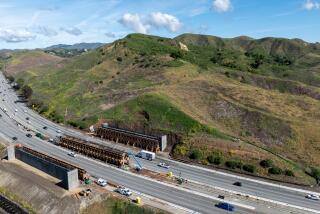San Diego Zoo, Audubon pair up to help save animals
SAN DIEGO — Two organizations known for their work in saving imperiled species agreed Tuesday to build a breeding center that will bring some of the world’s most exotic and endangered birds and hoofed mammals to a 1,000-acre site near the Mississippi River.
The new facility will include open-air enclosures for animals of more than two dozen species, including whooping cranes, okapis, bongos (a type of antelope), storks, flamingos, Masai giraffes, oryx and other creatures, under the agreement signed by San Diego Zoo Global and the New Orleans-based Audubon Nature Institute.
“They have the land and we have the majority of the species that need assistance,” said Robert Wiese, chief life sciences officer for San Diego Zoo Global, which manages field programs in 35 countries.
The partnership is based on the realization that animals breed better when they have room to roam. Even at the San Diego Zoo’s ample Safari Park, space has become pinched.
The new facility, south of New Orleans, is to be named the Alliance for Sustainable Wildlife.
Many of the species are imperiled by loss of habitat in their native Africa, officials said.
For example, the okapi, an unusual animal that looks a zebra but is related to the giraffe, is threatened by the volatile politics of Central Africa and the continued loss of dense rain forest habitat. The brightly colored bongo, among the largest of the African antelope species, is threatened by poaching and habitat loss in Central and West Africa.
“We want to retain a large population in case the worst happens in Africa,” Wiese said.
Jim Maddy, president and chief executive of the Assn. of Zoos and Aquariums, said the partnership “demonstrates the creativity and resourcefulness of these two great organizations.”
The Audubon Nature Institute, which operates museums and parks in the New Orleans area, owns the property, which already includes a research facility and a breeding center for cranes.
Construction at the center is set to begin this fall; the breeding program is expected to get underway next year. The San Diego Zoo will transfer some of its animals to the site. There are no plans in the first years to permit public access.
Douglas Myers, president of San Diego Zoo Global, said the two organizations hope the alliance “will be a model for collaborative efforts in the future.”
The 1,000-acre site has sufficient elevation and drainage to withstand flooding from storms that sweep in from the Gulf of Mexico, officials said. The site, once owned by the Coast Guard, suffered only slight damage from Hurricane Katrina in 2005.
Still, “there is no totally safe, risk-free place,” Wiese said.
More to Read
Sign up for Essential California
The most important California stories and recommendations in your inbox every morning.
You may occasionally receive promotional content from the Los Angeles Times.










